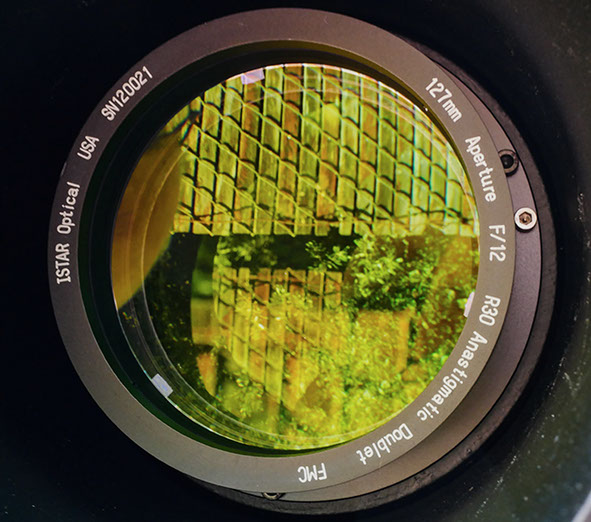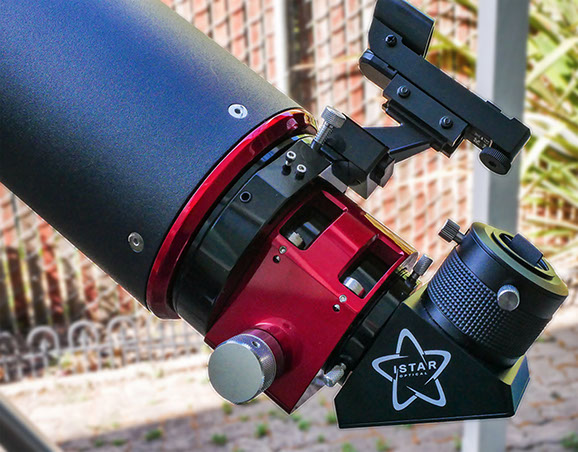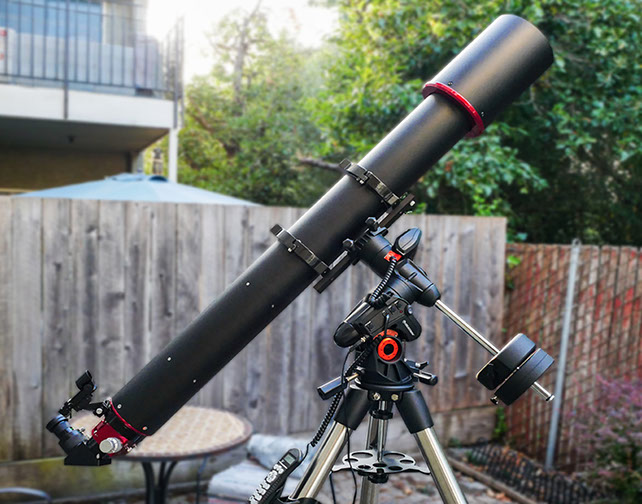iStar 127 mm (5”) R30 F/12 Doublet Refractor Review
___________________________________
Michael R. Nofi
____________________________________
My first telescope was a refractor. As a star struck 8-year-old it represented the ideal image of how a telescope should look. It was a model 9TE-5 Tasco 60 mm (2.4-inch) f/11.7 700 mm focal length alt-az telescope sold by Sears, Roebuck and Company. It was advertised disproportionally as a 234X telescope. With a refractor you could aim directly at the stars. In a Newtonian you look indirectly at the stars sideways. How a reflecting telescope works just didn’t make sense to my young mind. I have had several reflector telescopes over the last 60 years, but I always gravitate back to refractors.
I have always been a visual observer. The nights when the eye was the best detector for viewing critical details on lunar, solar, and planetary bodies changed in the mid-1990s ending a tradition of visual observing for scientific purposes that began 400 years ago. The advent of solid-state detector technology (e.g. CCD and CMOS) coupled with computer processing made it possible to exceed the amount of detail the eye could detect through “lucky imaging.” This new technology was quickly adopted by the amateur astronomer community.
Looking back, I was fortunate to have had 33 years of observing experience during a time when amateur astronomers could compete and occasionally exceed what professional astronomers could accomplish observing lunar and planetary objects. Still, to this day, I prefer to see photonic images of the many wonders of the universe directly on my retina. Is this silly? Perhaps.
Now is the best time to be an amateur astronomer, especially for refractor aficionados. Given the popularity of astronomical imaging, refractors are an excellent choice. They are perfect for grab-and-go astronomy and robust enough to be transportable. They are also affordable for most people. The main cost driver is the quality of the objective, which is dependent on the lens design, type of glass, and the care in fabricating the lens to a strict specification. The second most expensive item is usually the focuser.
Having observed with premier telescopes such as Stellarvue, APM, Astrophysics, TEC, William Optics, and Takahashi, the imaging quality of these exceptional products has set a new standard in refractor performance. Each manufacturer has a different design philosophy, but one thing they all have in common is these telescopes are smaller, lighter, easy to setup, store, and transport than their predecessors. Best of all, with the advent of the new ED and APO designs, the chromatic aberration that plagued refractors for over 400 years has been largely eliminated. Aperture for aperture, a high-end APO can exceed any other telescope design in terms of optical performance, irrespective of price. The future looks very bright for refractor telescopes.
Many of these premier telescopes come with a Strehl ratio optical certification. The Strehl ratio is defined as the central intensity in the aberrated pattern Airy disk over the central intensity in the unaberrated Airy disk. A Strehl of 1.0 is perfect. For reference, the Strehl of the ¼ Rayleigh’s limit Strehl is 0.80. There are many variables that define a good optic that one number cannot capture. Most observers can’t tell the difference in real world objects between a Strehl of 0.90 to 0.98. A star test will show the difference, but it takes a lot of patience to learn how to interpret star test patterns. Star testing can become an obsession. The test tends to be too sensitive and many fine optical systems do not meet the requirements of identical diffraction patterns on equal sides of focus. This is especially true of fast refractors (< f/7).
While the objective lens is the most important component, tube baffling, enhanced optical coatings, lens cell design, diagonal, and eyepieces are also critical.
Though suitable for visual observing, the new APO refractors are primarily designed and optimized for imaging. Fast refractors with shorter focal lengths (< 700 mm) do not make the best visual telescopes for lunar, planetary, and double star observing. To achieve a high magnification requires short focal length eyepieces with poor eye-relief. A Barlow can be inserted between the objective and the eyepiece as an image amplifier. These are built into many short focal length eyepieces, but all this extra glass and potential issues with collimation of stacked components can compromise image quality. Keep in mind that objective lens Strehl is not the same as total system Strehl. Many of the advantages of long focal length refractors are discussed in this review.
Cloudy Nights Classified
Several months ago, I saw an ad in Cloudy Nights for a used refractor. The scope was a 5-inch iStar f/12 doublet. I prefer the simplicity of doublet refractors because they achieve thermal equilibrium faster, they have superior image contrast, and a higher transmission factor than a triplet. Long focal length refractors are also less prone to errors in manufacturing tolerances (i.e., collimation, centration, wedge, and transmitted wavefront). In the future, the reduction in the cost of new optical glasses and aspherical generated lenses will simplify objective designs reducing them to no more than two elements making triplets unnecessary.
Several days passed and I could not stop thinking about the telescope. I showed pictures of it to my son for a second opinion. He asked me if this telescope is better than what I already had. My simple answer was not likely, since It would have more color. This was a “Eureka” moment. I realized that telescopes are like your children. You may have a favorite, but you love each one unconditionally, accepting their quirks, and flaws. Each telescope I own has a personality with characteristics are not easy to put your finger on. Some telescopes are immune to being judged for their optical performance alone. Sometimes it is not a question of one telescope design being better than another, but one of simply being different. For example, for observing Jupiter which is better—the view through a 6-inch f/8 Newtonian reflector, or a 6-inch f/8 achromat? All other things being equal.
I went on the Cloudy Nights refractor forum, to see what others thought of iStar Optics and telescopes. Reading through the threads there was a lot of interest and excitement about these new scopes. Questions about the company, the owner, where are the optics and tube assemblies made? Are the optics certified? Are these scopes any good? How do these scopes compare to the competition? Then someone had a bad experience with a telescope they ordered. It was most likely damaged in shipment. All second and third-hand information (nearly all one-sided) was shared on the forum. Speculation was rampant. Nasty emails followed and the owner of the company was literally roasted without any way to properly defend himself. This type of behavior continued for several weeks. For a new business, mostly dependent on the internet for communication and exposure to the marketplace for survival, this is a death blow. What a horrible thing to have happened. Worst, it severely damaged the company’s reputation. All started by one individual and then, unfortunately, others (like a hungry pack of hyenas) joined the cause.
What I know of the telescope business is this: No one goes into this business to make lots of money. The opportunity to get rich quick is just not there. People go into this business for the love of the hobby. The commercial telescope market thrives when there is competition. Where would Celestron be today without Meade (and vice versa)? Innovation occurs when we allow others with a different vision to bring new products to the market. As consumers we are all better off when there are more choices available to us. Competition also helps keep prices low.
The creation of every refractor telescope has an interesting story behind it (a story not often told). The design of a refractive optical system has many degrees of freedom, more so than any reflective optical design. This affords the optical engineer the freedom of choice when selecting lens design parameters, i.e., number of lens groups, number of lens elements, clear aperture, glass type (index and dispersion), radii of curvature, lens shape (e.g. spherical, aspherical, etc.), lens thickness, lens spacing and even the design of the optical coatings. The challenge is deciding how to work within and hopefully overcome many of the constraints dictated by the laws of physics and economics. Within these constraints, the lens designer designs a lens with performance properties of their choice. This makes each lens design unique, and to the lens designer personal. As a class of telescopes refractors have more character than any other telescope design.
The iStar telescope started as an idea in someone’s head. It was brought to market to provide a different astronomical experience to potential buyers. An experience that is manifested in optical performance. In a metaphorical sense it has a personality unlike any other design. The truth of the design resides in the star test and, most importantly, in the quality of the image seen through the eyepiece.
I am sure there were many obstacles for iStar along the way, as there is in any new business venture. And to think how much damage to one man’s dream can happen by one person trashing a company that he knows nothing about, merely by typing careless words on a keyboard. These are the same people that defend their actions as, “I was just expressing my opinion, which I may remind you I am entitled to!” They write an insult and then end it with LOL. If you take offense, they accuse you of not having a sense of humor.
I decided to go to the source and called iStar Optical to talk to the owner. He was friendly, and knowledgeable, and answered all my questions to my satisfaction. Like me, he loves refractors. After our conversation, I continued to search the internet for more information on iStar refractors. I asked myself, what differentiates these telescopes from others on the market? It appeared iStar’s strategy is to bring large aperture fast f/ratio refractors to the market primarily for use as deep sky (RFT) scopes. They also offer long focal length quality lenses, likely to compete with D&G. All the information on iStar was favorable, and while I did not find comparative reviews of these refractors, there were no negative reviews.
I preferred to buy a new telescope, but iStar no longer makes complete tube assemblies and I was not interested in purchasing an objective and building my own, so I purchased the used telescope posted on Cloudy Nights. The seller was a pleasure to work with, friendly, and knowledgeable. He gave me a good assessment of the performance of the telescope. It was everything the seller said it was and it arrived undamaged and in like-new condition.
Initial Impressions
It is huge and heavy, weighing in at about 27 lbs. with Parallax Instruments tube rings and steel Vixen style dove bar. I can still lift it though. The OTA is probably too large to be taking in and out of the house, so be careful with your sliding glass door!
The tube is fabricated out of 3 mm thick aluminum-magnesium alloy that you could mount under the wing of a fighter jet and launch missiles out of! No need to worry about denting it. It is powder coated with crinkled matte black paint, and, while black is not the best color for a telescope by day, it is a better color than white at night for two reasons. First, black helps to enhance and maintain night vision, and second, black paint has higher emissivity than white paint and will re-emit infrared heat faster than white. The matte finish also has more surface area than smooth paint which further enhances reradiation of heat. This is particularly important during cool down for nighttime observing.
The lens cell is massive, as is the dew shield, with the lens cell and glass alone weighing 6.6 lbs. The lens cell is easy to remove and features a push-pull hex bolt system for collimation. The lens diameter is 131 mm for a clear aperture of 127 mm, which is good because most lenses (from the final polishing process) have a small amount of edge turning. Having an oversized lens keeps this critical area of the lens outside of the clear aperture. In fact, it is possible to cheat when measuring the Strehl ratio by masking down the clear aperture ever so slightly (by several millimeters, or so).
This telescope is a new twist on a traditional achromat design. The lens was designed in the E.U. by Professor Zdenek Rehor and ground and polished in China. The tube assembly was designed, built and assembled by iStar owner Ales Patrick Krivanek in Arizona, USA. An equivalent European lens would likely cost twice as much.
The lens is described as a modified achromatic R30 (Anastigmatic) in iStar’s Rx lens series. It is hand figured to a monochromatic (yellow green) Strehl ratio of equal or greater than 0.93. By definition, an anastigmatic lens is corrected for spherical aberration, coma, and astigmatism. The minimum iStar surface quality for an optical figure is PV/4 which is ¼ wavelength (yellow green). The doublet is air spaced and uses crown glass and dense flint for color correction.
The lens design is optimized for the scotopic eye response (507 nm) which is biased toward the blue end of the visual spectrum. This gives the objective a minus red or cyan color balance and is an improvement over a standard achromat for both color correction and resolution. The difference becomes noticeable when viewing deep sky objects (especially open and globular clusters and planetary nebula). It should perform well on all the planets with some compromise in resolution in red objects, such as Mars.
The lens is optically pristine with no internal dust, sleeking, or underpolish. In the flashlight test at night I could not see a single sleek or dig on the surfaces of the lenses. Pitch polished glass has a certain “look” about it that is hard to describe. You often see it on Zeiss and Leica optics. The glass in this lens has that look.
Both lens elements are fully multicoated with a SiO2 based design. The specification states it is a broadband AR design. The optical coating is greenish-yellow in reflected color, uniform, blemish, and stain free. The stated focal length is 1476 mm with a clear aperture of 127 mm and an f/ratio is f/11.6, not f/12 as stated on the lens cell.
There may be some confusion about the meaning of the “R30” prescription rating for the objective. The R value is a measure of the improvement in color correction for a doublet objective relative to a standard achromat. Expressed in percent reduction in chromatic aberration, the R value limits are 0.0 (0%) for an achromat and 1.0 (100%) for a true APO.
The R value can be multiplied by the f# to get the equivalent f# in terms of a reduction in chromatic aberration (CA).
![]()
For a refractor, the amount of CA decreases by the lens diameter divided by the f/ratio.
Over 75 years ago, Sidgwick and Conrady each made a recommendation for setting a minimum CA ratio for an acceptable level of CA for achromatic refractors.
![]()
where f# is f/ratio or f-number and D is the objective diameter in inches.
The Sidgwick standard sets a minimum CA ratio of 3.0 versus the more stringent Conrady minimum standard of 5.0. As a point of reference my first 2.4-inch (60 mm) f/11.7 refractor had CA of 4.9 which is close to the Conrady standard and I do not recall seeing any signs of secondary color in this telescope. Applying the Sidgwick and Conrady standards to a 5-inch achromat specifies a minimum lens f/ratio of:
Sidgwick: f/15 and Conrady: f/25
If the iStar 5-inch f/11.6 system was a standard achromat the CA ratio would be:
![]() This falls short of both CA standards and would require color filtration to achieve an acceptable level
This falls short of both CA standards and would require color filtration to achieve an acceptable level
of performance.
Applying the R value as a factor in the chromatic aberration (CA) ratio calculation the chromatic aberration ratio for the iStar 5-inch R30 f/11.6 design becomes:
![]()
A CA ratio of 3.02 just exceeds the Sidgwick requirement, upgrading the performance of the scope to the category of an ED objective, but not to the level of a semi-APO.
According to Sidgwick, a 3.02 CA should have little or no chromatic aberration. Based on my visual observations it falls short of this expectation, but there is no question that the reduction in color is better than a standard 5-inch f/11.6 achromat. Calculating the % reduction in CA of the iStar compared to a standard achromat works out to be 30% (i.e., R30).
Let’s get back to the fun stuff. The rear tube ring and lens mounting ring are red gel coated polished aluminum. The candy red accent is attractive. Tube baffles (qty. 4) are the best I have seen in any telescope, regardless of price. They are screwed in place with flush mounted polished stainless-steel hex screws. The objective facing light baffles have a black foam annular ring adhesive mounted to the face of the black painted metal baffles to further absorb stray light. iStar pays attention to details.
The red anodized MoonLite 2-inch two-speed focuser is a perfect match for the telescope. I recently purchased an iStar 99.9% all dielectric 2-inch diagonal. The mirror is 10 mm thick BK7 with a 1/10 wave flatness rating. The measured FSM surface for scatter is less than a couple of my higher end 2-inch diagonals.
First Light
I first mounted the OTA on an Explore Scientific Twilight II alt-az mount with an extended pier with 22 lbs. of transverse counterweight. While this setup was workable, the OTA proved to be too much for the mount. Next I tried mounting it to an FTX ver. 1 alt-az mount which handled the load quite well, but the Berlebach UNI 14 Astro wood tripod was too small. Finally, I mounted it on my Celestron AVX GOTO equatorial mount and with proper counterweights it worked surprisingly well. When the tube is pointing east and west, the settling time at the eyepiece is about 3 seconds.
 Chromatic aberration is noticeable on brighter stars (as a deep blue halo). I am particularly sensitive to it, but it is not noticeable on stars greater than 2.0 magnitude. The previous owner commented that the amount of chromatic aberration in the iStar was the same as his 5-inch f/15 D&G achromat refractor.
Chromatic aberration is noticeable on brighter stars (as a deep blue halo). I am particularly sensitive to it, but it is not noticeable on stars greater than 2.0 magnitude. The previous owner commented that the amount of chromatic aberration in the iStar was the same as his 5-inch f/15 D&G achromat refractor.
The iStar has slightly less secondary color than a 1990s vintage Meade 5-inch f/9.3 Semi-APO ED and significantly less color than a Vixen Neo-Achromat NA140 mm SS f/5.7. Even though the Vixen Petzval 4-element refractor is an improvement over a standard achromat, it still has too much color. This scope came out 20 years ago and surprisingly, it is still being sold today.
The first large aperture triplet I purchased was a Meade’s Series 5000 5-inch f/7.5 Triplet ED APO. While it has less color than the iStar it was more than I expected from a triplet, limiting telescope magnification to (150X) on the Moon. I paid nearly $2,000 for this scope back in 2009. The tube assembly is front heavy, and the objective takes 45 minutes to thermally equilibrate. Field curvature is excessive, and the stars are bloated beyond 2/3 of the field of view.
In summary, the amount of color in the iStar is acceptable. Compared to the other fine attributes of the telescope, this aberration is easy to overlook.
Double Stars: The 5-inch performs admirably on double stars and eats them for a late-night snack. On nights of good seeing I was able to routinely separate double stars at magnifications of (150X) to (300X) to the theoretical limit. It does very well when detecting faint secondary stars near their primary star. One of my favorite views is Tyl (Epsilon Draconis). This is a 3.8 magnitude yellow primary with a 6.9 magnitude pale blue secondary separated by 3.2 arc seconds. A gorgeous double worth checking out! The previous owner was able to resolve 52 Orionis which is separated by 1.1 arc seconds both components magnitude 6.2 and saw two perfect disks with black sky between them. The objective holds up under high magnification (350X), behaving more like a larger telescope. Double star color is only slightly biased due to secondary spectrum. Faint secondaries are as small of a pinpoint as the definition of pinpoint will allow!
Moon: Good image contrast with some residual blue secondary spectrum visible in the lunar shadows beginning at (100X) and increasing up to maximum magnification. Missing is the red secondary color component which gives the haze of light in the shadows a distinctly magenta (or purple) hue. Craters (i.e., Tycho, Clavius, and Copernicus) are sharp, showing good contrast at high magnification (150X). All surface features are in focus over most of the field of view, and, under good seeing, I was able to see small craterlets at the very limit of resolution. A genuinely nice lunar scope.
Planets: Jupiter and Saturn show a narrow blue halo. The contrast in the cloud bands and zones is excellent and not overly compromised by residual CA. The color of Saturn is more white than creamy yellow or butterscotch. In moments of good seeing, structure can be seen in Jupiter’s Great Red Spot. In terms of CA, the color balance is cooler, biased toward the blue. This reduces the warmer colors in the planets, in particular red, though there is still plenty of orange-brown in Jupiter’s bands! Mars will be a good object to evaluate the objectives correction to red light.
Deep Sky: The iStar excels on deep sky objects, which typically is not a strong application for refractors. The flat field, lack of coma and astigmatism make for wonderful views of star fields. Both bright and faint stars show beautiful diffraction disks. Under good seeing, it is easy to determine when best focus, is achieved, occurring when the last vestiges of axial transverse CA disappear. Most of the stars in M13 are resolved into the core, giving an icy-blue 3D effect.
This lens really shines on stellar objects. Herschel’s Garnet Star (Mu Cephei) is a ruddy gem of a star – a beautiful orange–red hard diffraction disk. At (37X) Mizar and Alcor are very prominent in the field of view, burning so bright it dazzles the eye. When you focus on an open cluster, the first thing you notice are the pinpoint star images. You never see stars like this in a SCT! In side-by-side views of extended sources, the 5-inch has better contrast than the 8-inch SCT even though the 5-inch only has about 60% of the light gathering power of the 8-inch SCT.
Star Testing: Intra and extra focal images viewed through a green filter are nearly identical. Star testing shows correction between a 1/6th and 1/8th wavelength (estimated based on prior experience with testing telescopes).
Ronchi Null Test: Nice straight bands, right to the very edge of the aperture. Smooth optical surfaces are seen just off of the null point.
Tip: Use the Ronchi test to determine when the objective reaches thermal equilibrium.
My Favorite Telescope?
Unequivocally, yes! Five inches of aperture is a good compromise between size, weight, light gather power, focal length, resolution, and the ability to utilize 1 arc second of resolving power on nights of good seeing. On most nights, I can see beautiful, hard, eye-popping Airy disks.
The doublet lens takes less than 20 minutes to reach thermal equilibrium. The lens is not so thick to absorb and scatter too much light. At f/11.6 the objective has a flat field (similar to the Vixen NA140 mm Petzval design). Coupled with a 56 mm 2-inch Plossl eyepiece the iStar gives (26X) turning the scope into an RFT with a 2-degree FOV and an exit pupil of just under 5 mm (perfect for a person my age).
The slow f# has a generous depth of focus:
![]() is the amount of defocus that falls within a ± λ/4 wavefront error making it easy to achieve and maintain a sharp focus.
is the amount of defocus that falls within a ± λ/4 wavefront error making it easy to achieve and maintain a sharp focus.
Is climate change affecting the good astronomical seeing that I recall from years past? Over the last 15 years the seeing is so bad at my location that I considered taking a break from observational astronomy. On nights of bad seeing, where the object is fluttering in and out of focus, the greater depth of focus allows the image to stay in focus longer. With short focal length refractors, you have to chase the focus to keep a sharp image and if the telescope mount is shaky, good luck focusing on a bouncing image! Unlike slow optical systems (> f/8), fast optics require a two-speed focuser for fine focus adjustment. Another advantage of slow optics is they demand less correction from the eyepiece.
The number of nights of good seeing have more than doubled. The objective lens is 7 feet above the ground which improves local seeing and isolates the observer’s warm body away from the entrance aperture. Options for improving astronomical seeing are limited, so how much is an improvement of (1/5) to (2/5) on the Antoniadi scale worth?
Over the last month I have been observing the double star Izar in Bootes and have not had one night where I was not able to easily resolve the secondary with plenty of dark space between the components. None of these nights fell below (3/5) on the Antoniadi scale. Observing under similar conditions with a short focal length APO refractor, I rarely saw an Airy disk during poor seeing.
Using a more traditional refractor with roots in the past creates a bit of nostalgia. What little chromatic aberration remains adds to the overall experience. I am looking at the same objects that other amateurs have viewed over the last 400 years. As mentioned earlier, sometimes it is not a question of which is better, but more about being different.
The optical quality of the visual images seen through this telescope are nearly equal to my best APO. You can see differences in side-by-side comparison (notably color and contrast), but the differences are subtle. An APO has the edge in terms of “truth in image fidelity.”
Making side-by-side comparisons by alternating between telescopes takes a lot of time (with changes in seeing and trying to match magnifications using the same eyepiece). If you spend the time you will likely be able to glean a bit more information out of the superior telescope, but if differences are not quickly obvious it may be time to move on, accept the telescope as is, and use it to enjoy the views of the night sky.
One should consider the other features the iStar offers, e.g. flat field, long f/ratio, depth of focus, faster cool down, location of objective away from heat sources, use of simple eyepieces, and relaxed optomechanical tolerances. Speaking of optical tolerances, it is not well known that refractors are more forgiving of errors in optical figure than reflectors. The wavefront error (ε) of a refractive optical surface is given by:
![]() where δ is depth or height of defect
where δ is depth or height of defect
and n is the refractive index of the glass.
A mirror by comparison is ε = 2δ. All these positive attributes enhance the observing experience, and I would not trade them for an increase in a Strehl of 0.90 to 0.98.
Another reason I enjoy this telescope so much has to do with outreach astronomy. Kids love big telescopes and no telescope shouts “telescope!” better than a large refractor. I tell the kids that this is the telescope Darth Vader used to keep his eye on the rebels on the planet Alderaan. The telescope is big, dark, and ominous!
During special events, when I have my telescopes on parade, I ask my beautiful grandkids which telescope they like best and their unanimous response is, “the big black one, Grandpa!” Frankly, at this stage of my life, that is good enough for me.








